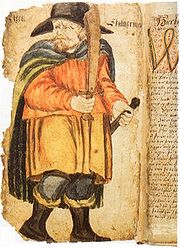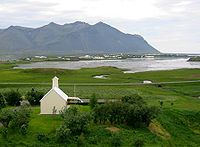
Egils saga
Encyclopedia

Epic poetry
An epic is a lengthy narrative poem, ordinarily concerning a serious subject containing details of heroic deeds and events significant to a culture or nation. Oral poetry may qualify as an epic, and Albert Lord and Milman Parry have argued that classical epics were fundamentally an oral poetic form...
Icelandic saga. The oldest transcript (a fragment) dates back to 1240 AD. The saga is centered on the life of Egill Skallagrímsson
Egill Skallagrímsson
Egill Skallagrímsson was a Viking Age warrior and skald. Egill is one of the great anti-heroes of the Icelandic sagas.-Life:...
, an Icelandic farmer, viking
Viking
The term Viking is customarily used to refer to the Norse explorers, warriors, merchants, and pirates who raided, traded, explored and settled in wide areas of Europe, Asia and the North Atlantic islands from the late 8th to the mid-11th century.These Norsemen used their famed longships to...
and skald
Skald
The skald was a member of a group of poets, whose courtly poetry is associated with the courts of Scandinavian and Icelandic leaders during the Viking Age, who composed and performed renditions of aspects of what we now characterise as Old Norse poetry .The most prevalent metre of skaldic poetry is...
. It is generally referred to as "Egla" by Icelandic scholars.
The saga covers a long period of time, starting in Norway around 850 AD, with the life of Egill's grandfather Úlfr
Kveldulf Bjalfason
Ulf Bjalfason was a renowned hersir and landowner in ninth century Sogn, Norway. He is a main character in the early chapters of Egils Saga and appears in the Landnamabok and other Icelandic sources...
, called Kveldúlfr ("Evening Wolf") and his two sons, Þórólfr and Egill's father Skalla-Grímr
Skalla-Grímr
Skalla-Grímr Kveldulfsson was a Norwegian, who was forced to emigrate to Iceland in the days of his enemy Harald Fairhair. His main claim to fame is that he was the father of Egill, but he also deserves a footnote in the history of Nordic literature for having composed the following stanza:...
. Kveldúlfr is described as bigger and stronger than anyone else gaining much land and property from viking raids. He was a very wise man, hamrammr (a shape-shifter) in battles and a shy recluse in the evenings. Extreme personal traits like these are seen in his son Skalla-Grímr and his grandson Egill as well. After Þórólfr's death, due to his broken allegiance to King Haraldr
Harald I of Norway
Harald Fairhair or Harald Finehair , , son of Halfdan the Black, was the first king of Norway.-Background:Little is known of the historical Harald...
(although not Þórólfr's fault), Skalla-Grímr and his father Kveldúlfr flee Norway to settle in Iceland. Skalla-Grímr settles in peace as a farmer and blacksmith at Borg, where his sons Egill and Þórólfr (named after his uncle) grow up.
The story continues with the childhood of Egill, which foreshadows his future rebelliousness. His family's peace is again lost as the social order is threatened by Egill's dangerous attitude. He stirs up trouble with his first murder with an axe at the age of seven. The story goes on to tell the tales of Egill's voyages to Scandinavia
Scandinavia
Scandinavia is a cultural, historical and ethno-linguistic region in northern Europe that includes the three kingdoms of Denmark, Norway and Sweden, characterized by their common ethno-cultural heritage and language. Modern Norway and Sweden proper are situated on the Scandinavian Peninsula,...
and England
England
England is a country that is part of the United Kingdom. It shares land borders with Scotland to the north and Wales to the west; the Irish Sea is to the north west, the Celtic Sea to the south west, with the North Sea to the east and the English Channel to the south separating it from continental...
and his personal vendetta
Feud
A feud , referred to in more extreme cases as a blood feud, vendetta, faida, or private war, is a long-running argument or fight between parties—often groups of people, especially families or clans. Feuds begin because one party perceives itself to have been attacked, insulted or wronged by another...
against King Eric Bloodaxe
Eric Bloodaxe
Eric Haraldsson , nicknamed ‘Bloodaxe’ , was a 10th-century Scandinavian ruler. He is thought to have had short-lived terms as the second king of Norway and possibly as the last independent ruler of the kingdom of Northumbria Eric Haraldsson (Eric, anglicised form of ; died 954), nicknamed...
. There are also vivid descriptions of his other fights and friendships, his relationship with his family (highlighted by his jealousy, as well as fondness for his older brother Þórólfr), his old age, and the fate of his own son Þorsteinn (who was baptized once Roman Catholicism came to Iceland) and his children who had many children of their own. The saga ends around the year 1000 AD and spans many generations.
The saga follows Egill through the various stages of his life, most of which are surrounded by battle and Egill virtually narrates his own life story with his frequent segments of poetry. Before Egill died he allegedly concealed his silver
Silver
Silver is a metallic chemical element with the chemical symbol Ag and atomic number 47. A soft, white, lustrous transition metal, it has the highest electrical conductivity of any element and the highest thermal conductivity of any metal...
treasure near Mosfellsbær
Mosfellsbær
Mosfellsbær is a town in south-west Iceland, situated some east of the country's capital, Reykjavík. It has a total area of and its population as of September, 2011 was 8,886....
, giving birth to the legend of silfur Egils ("Egill's Silver").

As a work of literature, Egils saga is generally considered to be amongst the best of the Icelandic sagas, along with Njáls saga and Laxdæla saga.
Sources for this article
- Jones, Gwyn. A History of the Vikings. 1968.
- Thorsson, Örnólfur, et al. :The Sagas of the Icelanders: a selection, "Egil's Saga: Egils saga" trans: Bernard Scudder (Penguin Classics, 2000).
External links
- Egils saga Skalla-Grímssonar from heimskringla.no
- English translation at the Icelandic Saga Database
- Text in Icelandic
- ISBN 0-14-044321-5
- An analysis of the Paget's Disease theory
- Proverbs in Egils saga

